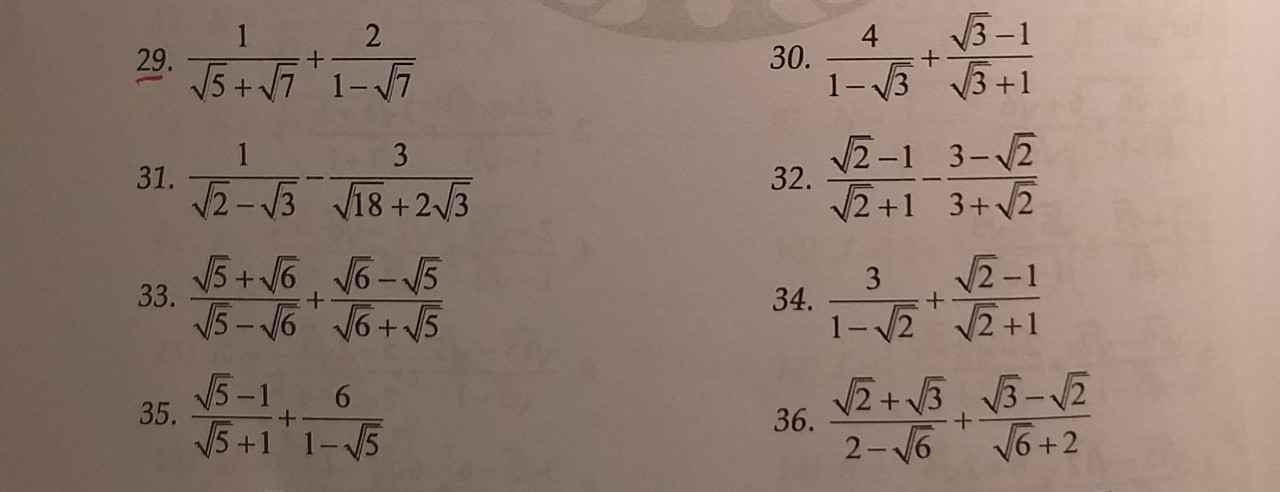
Hãy nhập câu hỏi của bạn vào đây, nếu là tài khoản VIP, bạn sẽ được ưu tiên trả lời.


84 - 4 x ( 2y + 1 ) = 4
4 x ( 2y + 1 ) = 80
2y + 1 = 20
2y = 19
y = 19/2

x+y+z=xyz+1
Giả sử x lớn hơn =y lớn hơn =z
=> 3x> xyz+1 >xyz
=> 3> yz
do y,z nguyên dương nnee tìm đc y,z

Ta có
\(\hept{\begin{cases}2x^2-y^2=1\left(1\right)\\xy+x^2=2\end{cases}}\)\(\Rightarrow\hept{\begin{cases}4x^2-2y^2=2\left(2\right)\\xy+x^2=2\left(3\right)\end{cases}}\)
trừ (2) cho (3) vế với vế ta được
\(3x^2-2y^2-xy=0\Rightarrow3x\left(x-y\right)+2y\left(x-y\right)=0\)
\(\Rightarrow\left(x-y\right)\left(3x+2y\right)=0\)
\(\Rightarrow\orbr{\begin{cases}x-y=0\\3x+2y=0\end{cases}\Rightarrow\orbr{\begin{cases}x=y\\x=-\frac{2y}{3}\end{cases}}}\)
Sau đó bạn thay vào (1) rồi giải tiếp nhé

Gọi thời gian làm riêng để hoàn thành công việc tổ 1 ; 2 lần lượt là a ; b ( a ; b > 0 )
Theo bài ra ta có hệ \(\left\{{}\begin{matrix}\dfrac{1}{a}+\dfrac{1}{b}=\dfrac{1}{12}\\\dfrac{9}{a}+\dfrac{1}{2}.\dfrac{10}{b}+\dfrac{9}{b}=1\end{matrix}\right.\Leftrightarrow\left\{{}\begin{matrix}\dfrac{1}{a}=\dfrac{1}{30}\\\dfrac{1}{b}=\dfrac{1}{20}\end{matrix}\right.\Leftrightarrow\left\{{}\begin{matrix}a=30\\b=20\end{matrix}\right.\)(tm)
Vậy ...

Ta thấy \(y^2+2xy+x^2-x^2-7x+12=0\)
\(\Leftrightarrow\left(x+y\right)^2=x^2+7x+12\)
\(\Leftrightarrow\left(x+y\right)^2=\left(x+3\right)\left(x+4\right)\)(1)
Vì\(x,y\varepsilonℤ\)nên\(\left(x+y\right)^2\)là số chính phương và \(\left(x+3\right)\left(x+4\right)\)là tích 2 số nguyên liên tiếp (2)
Từ (1) và (2) ta được
\(\hept{\begin{cases}\left(x+y\right)^2=0\\\left(x+3\right)\left(x+4\right)=0\end{cases}}\)\(\Leftrightarrow\hept{\begin{cases}x+y=0\\\orbr{\begin{cases}x+3=0\\x+4=0\end{cases}}\end{cases}}\)
Giải ra tìm được x,y
\(\hept{\begin{cases}\left(x+y\right)^2=0\\\orbr{\begin{cases}x+3=0\\x+4=0\end{cases}}\end{cases}}\)
Căn x >-1 thì có tìm được x không ạ. Nếu được giải ra giúp mình nhá còn không thì chỉ là tại sao nhá

\(\sqrt{x}>-1=>\sqrt{x}+1>0\)(1)
ta thấy \(\sqrt{x}\ge0=>\sqrt{x}+1\ge1\left(2\right)\)
(1)(2)=>vô lí nên ko tìm đc x

ĐKXĐ: \(x\ge0;x\ne4.\)
\(A=\frac{x}{x-4}+\frac{1}{\sqrt{x}-2}+\frac{1}{\sqrt{x}+2}.\)
\(=\frac{x}{\left(\sqrt{x}-2\right)\left(\sqrt{x}+2\right)}+\frac{\sqrt{x}+2}{\left(\sqrt{x}-2\right)\left(\sqrt{x}+2\right)}+\frac{\sqrt{x}-2}{\left(\sqrt{x}+2\right)\left(\sqrt{x}-2\right)}\)
\(=\frac{x+\sqrt{x}+2+\sqrt{x}-2}{\left(\sqrt{x}+2\right)\left(\sqrt{x}-2\right)}=\frac{x+2\sqrt{x}}{\left(\sqrt{x}+2\right)\left(\sqrt{x}-2\right)}.\)
\(=\frac{\sqrt{x}\left(\sqrt{x}+2\right)}{\left(\sqrt{x}+2\right)\left(\sqrt{x}-2\right)}=\frac{\sqrt{x}}{\sqrt{x}-2}.\)
b) Để \(A=\frac{5}{4}\)\(\Leftrightarrow\frac{\sqrt{x}}{\sqrt{x}-2}=\frac{5}{4}\Leftrightarrow\frac{4\sqrt{x}}{4\left(\sqrt{x}-2\right)}-\frac{5\left(\sqrt{x}-2\right)}{4\left(\sqrt{x}-2\right)}=0\)
\(\Leftrightarrow\frac{4\sqrt{x}-5\sqrt{x}+10}{4\left(\sqrt{x}-2\right)}=0\Leftrightarrow-\sqrt{x}+10=0\)
\(\Leftrightarrow\sqrt{x}=10\Leftrightarrow x=100\left(tmđk\right).\)
Vậy để A=5/4 thì x=100
Tự tìm ĐK nha
a) \(A=\frac{x}{x-4}+\frac{1}{\sqrt{x}-2}+\frac{1}{\sqrt{x}+2}\)
\(A=\frac{x}{\left(\sqrt{x}+2\right)\left(\sqrt{x}-2\right)}+\frac{\sqrt{x}+2}{\left(\sqrt{x}+2\right)\left(\sqrt{x}-2\right)}+\frac{\sqrt{x}-2}{\left(\sqrt{x}+2\right)\left(\sqrt{x}-2\right)}\)
\(A=\frac{x+\sqrt{x}+2+\sqrt{x}-2}{\left(\sqrt{x}+2\right)\left(\sqrt{x}-2\right)}\)
\(A=\frac{x+2\sqrt{x}}{\left(\sqrt{x}+2\right)\left(\sqrt{x}-2\right)}\)
\(A=\frac{\sqrt{x}\left(\sqrt{x}+2\right)}{\left(\sqrt{x}+2\right)\left(\sqrt{x}-2\right)}\)
\(A=\frac{\sqrt{x}}{\sqrt{x}-2}\)
b) \(A=\frac{5}{4}\Leftrightarrow\frac{\sqrt{x}}{\sqrt{x}-2}=\frac{5}{4}\)
\(\Leftrightarrow4\sqrt{x}=5\left(\sqrt{x}-2\right)\)
\(\Leftrightarrow4\sqrt{x}=5\sqrt{x}-10\)
\(\Leftrightarrow\sqrt{x}=10\)
\(\Leftrightarrow x=100\)( thỏa mãn )
Vậy...

29: Ta có: \(\dfrac{1}{\sqrt{7}+\sqrt{5}}+\dfrac{2}{1-\sqrt{7}}\)
\(=\dfrac{\sqrt{7}-\sqrt{5}}{2}-\dfrac{2\sqrt{7}-2}{6}\)
\(=\dfrac{3\sqrt{7}-3\sqrt{5}-2\sqrt{7}+2}{6}\)
\(=\dfrac{-3\sqrt{5}-2}{6}\)
30: Ta có: \(\dfrac{4}{1-\sqrt{3}}+\dfrac{\sqrt{3}-1}{\sqrt{3}+1}\)
\(=\dfrac{-4\sqrt{3}-4}{2}+\dfrac{4-2\sqrt{3}}{2}\)
\(=\dfrac{-4\sqrt{3}-4+4-2\sqrt{3}}{2}=-3\sqrt{3}\)
31: Ta có: \(\dfrac{1}{\sqrt{2}-\sqrt{3}}-\dfrac{3}{\sqrt{18}+2\sqrt{3}}\)
\(=-\sqrt{3}-\sqrt{2}-\dfrac{3}{3\sqrt{2}+2\sqrt{3}}\)
\(=-\sqrt{3}-\sqrt{2}-\dfrac{9\sqrt{2}-6\sqrt{3}}{6}\)
\(=\dfrac{-6\sqrt{3}-6\sqrt{2}-9\sqrt{2}+6\sqrt{3}}{6}=\dfrac{-15\sqrt{2}}{6}\)
\(=\dfrac{-5\sqrt{2}}{2}\)
29.
\(=\frac{\sqrt{7}-\sqrt{5}}{(\sqrt{7}-\sqrt{5})(\sqrt{7}+\sqrt{5})}+\frac{2(1+\sqrt{7})}{(1-\sqrt{7})(1+\sqrt{7})}\)
\(=\frac{\sqrt{7}-\sqrt{5}}{7-5}+\frac{2(1+\sqrt{7})}{1-7}=\frac{\sqrt{7}-\sqrt{5}}{2}-\frac{1+\sqrt{7}}{3}=\frac{\sqrt{7}-3\sqrt{5}-2}{6}\)


- ( x + 84 ) + 213 = -16
- (x + 84 )= -16- 213
- x - 84 = - 229
- x = -229 + 84
- x = -145
x = 145